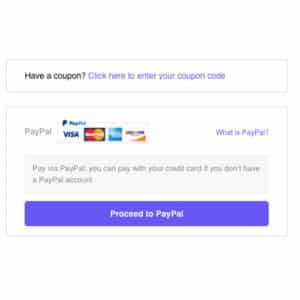How to Solve the Shopping Cart Abandonment Problem

It’s every online business’s worst nightmare. You have a customer, who is interested in your product, adds it to their cart, and then abandons the purchase without completing it. Only three out of 10 customers who added item/s to their cart completed the purchase.
This means seven out of 10 customers leave your store with empty hands — and an empty shopping cart. But this doesn’t have to be the case. Keep reading to find out how to solve the shopping cart abandonment problem and increase sales for your business!
Find Out Why Customers Abandon Carts
The first step in solving the shopping cart abandonment problem is to find out why customers are abandoning carts in the first place. This can be done by conducting customer surveys, analyzing customer data and feedback, and using heat maps to track where customers click on your website. Once you have this information, you can start making changes that will help reduce your abandoned cart rates.
Top Reasons for Shopping Cart Abandonment
You’ve gone through the trouble of creating an e-commerce website, populating it with products, and driving traffic to the site. But then customers add products to their shopping carts and abandon them. Let’s look at some of the top reasons for shopping cart abandonment.
Mandatory Account Creation
One of the biggest turnoffs for customers is creating an account before they can check out. Account creation can be a lengthy process, and customers want to get in and out as quickly as possible when they shop online. This is especially true if new customers just found your store while looking for a product they need.
If creating an account is mandatory to purchase something, customers will likely abandon their cart and shop elsewhere instead.
To combat this issue, consider giving customers the option to check out as guests or provide them with incentives such as discounts or free shipping in exchange for creating an account.
Complicated Checkout Process
Another major reason why customers abandon their carts is because of a complicated checkout process. Customers don’t want to have to fill out long forms or answer multiple questions before they can complete their purchase—they want a quick and easy way to pay for what they need and move on with their day.
Optimize your checkout process by eliminating unnecessary steps, including unneeded fields in forms, and streamlining payment options so customers can easily find what they need without hassle.
Insufficient Return Policy
Customers want assurance that they can return a product if it doesn’t meet their expectations or if something goes wrong with the purchase. If your return policy doesn’t provide them enough protection, they might choose not to buy from you in favor of another seller who offers better returns options. Ensure your return policy is straightforward and comprehensive so customers have confidence when purchasing from your store.
Unexpected Shipping Costs
Nobody likes unexpected costs popping up during checkout, especially regarding shipping fees. Customers who are surprised by high shipping costs or hidden fees are likely to abandon their carts rather than pay more than expected for their purchase.
To avoid this issue, be upfront about all costs associated with ordering from your store – include any fees in the initial price quote, so customers know exactly what they’re paying for before they get started with checkout.
Delivery Time Is Too Long
Shoppers today want instant gratification—if they can’t get what they need right away, they’ll leave your website searching for another retailer who can provide quicker delivery times. One way to combat this is to offer more options for delivery, such as same-day or next-day delivery so that shoppers have more choices and don’t feel like they’re waiting too long for their order to arrive.
Site Speed Performance
Nobody wants to wait for a slow website; if your site takes too long to load, shoppers will likely give up and leave without purchasing anything.
Improving your site speed performance is key here—make sure all images and videos are optimized for web, use a content delivery network (CDN) if necessary, enable caching, and regularly audit your code to identify any potential performance issues.
Optimizing your website for speed and ensuring it runs smoothly can help improve customer experience and reduce cart abandonment rates.
How to Solve the Shopping Cart Abandonment Problem
Make Checkout as Simple as Possible
One of the most common causes of abandoned carts is a complicated checkout process. If customers have too many hoops to jump through before completing a purchase, they may give up and move on to another store that offers a much simpler process.
To prevent this from happening, make sure your checkout process is as smooth and user-friendly as possible. Remove any unnecessary steps and ensure all fields are clearly labeled so customers know exactly what information they need to provide. This will ensure your checkout process is fast and easy for everyone involved!
Offer Multiple Payment Options
Another way to prevent shopping cart abandonment is by offering multiple payment options at checkout. Not all customers prefer traditional payment methods like credit or debit cards; some may pay via PayPal or other digital wallets like Apple Pay or Google Pay.
By offering different payment options at checkout, you increase the chances that every customer will be able to find a payment method that works for them — which means fewer abandoned carts!
Utilize Exit-Intent Popups
Exit-intent popups are modal windows that appear when users try to leave your site without completing an order. They usually contain special offers such as discounts or free shipping to persuade customers to stay and complete their order.
These popups work best when used sparingly, so use them only if absolutely necessary—otherwise, you risk annoying potential customers instead of enticing them into finishing their orders.
Provide Real-Time Assistance
Sometimes customers need help while trying to complete an order—especially if they have questions about your product or service. Providing real-time assistance via chat support can help alleviate any confusion or hesitations customers may have during checkout and increase the chance that they will finish their orders successfully.
Ensure Delivery Time Is Trackable
One way businesses can reduce shopping cart abandonment is by ensuring that delivery times are trackable so that customers know when their purchases will arrive at their doorstep after they complete checkout.
This transparency helps increase trust between buyers and sellers, which could lead potential buyers back into your store if they had abandoned their carts previously due to timing concerns.
Conclusion
Shopping cart abandonment is an ongoing problem facing online retailers today. However, by taking proactive steps can help reduce shopping cart abandonment rates and increase conversions significantly over time! With these tips in mind, you should be well on your way to reducing shopping cart abandonment and boosting your sales numbers!











